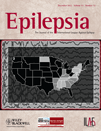Geographic variation of epilepsy for older Americans: How close to the geographic variation of stroke?
Summary
Purpose: Given the strong association of stroke and epilepsy in older persons, and the existence of a Stroke Belt in the United States, we hypothesized that geographic variation in epilepsy prevalence would follow geographic patterns similar to stroke.
Methods: We used a 2005 5% random sample of Medicare beneficiaries 65 and older in 48 U.S. contiguous states. Epilepsy was identified from claims for physician visits, hospitalizations, and outpatient procedures. Prevalence was obtained by state and county. Logistic regressions determined the independent association of the likelihood of epilepsy (prevalent or new case) and residence in Stroke Belt states, controlling for residence in highest epilepsy prevalence states, demographics (race, age, gender), comorbid conditions, cerebrovascular disease, dementia, and county characteristics.
Key Findings: Of 1,212,015 beneficiaries, 11.9 per 1,000 had prevalent and 2.9 new cases of epilepsy. Nine of 11 Stroke Belt states were among the 20 states with the highest epilepsy prevalence. Counties in the 10 highest epilepsy prevalence states were more likely to be large urban counties with a higher number of neurologists or neurosurgeons per capita. The higher likelihood of prevalent epilepsy cases associated with Stroke Belt residence was explained by beneficiaries’ race; that associated with residence in high epilepsy prevalence states was not. The likelihood of new epilepsy cases was negatively associated with Stroke Belt residence when controlling for covariates.
Significance: The geographic variation in epilepsy prevalence is not explained by variations in known risk factors. Further research should investigate why eastern U.S. states have higher frequency of epilepsy.




